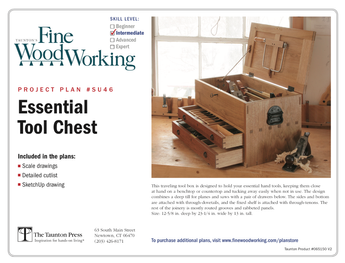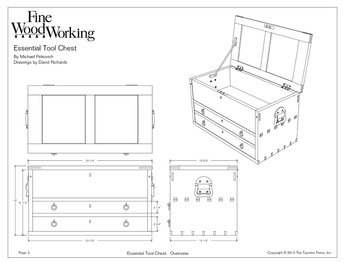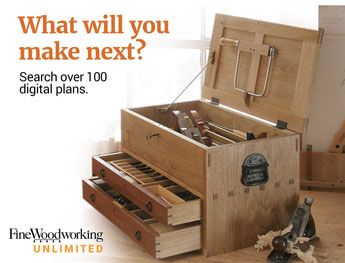Hi everyone! I have one 220v circuit in my garage and I’m trying to decide which tool I should purchase for it. A Sawstop PCS, an Onidea Supercell, or a CNC with a 220v spindle. I can’t run another circuit without a major service upgrade and a new panel, but I do have two 110v 20amp circuits available. Eventually (years away) I’ll have all three, but which two do you think should be the 110 versions? Also, I currently have a Sawstop jobsite saw, and a shop vac.
Discussion Forum
Get It All!
UNLIMITED Membership is like taking a master class in woodworking for less than $10 a month.
Start Your Free TrialCategories
Discussion Forum
Digital Plans Library
Member exclusive! – Plans for everyone – from beginners to experts – right at your fingertips.
Highlights
-
Shape Your Skills
when you sign up for our emails
This site is protected by reCAPTCHA and the Google Privacy Policy and Terms of Service apply. -
 Shop Talk Live Podcast
Shop Talk Live Podcast -
 Our favorite articles and videos
Our favorite articles and videos -
E-Learning Courses from Fine Woodworking
-
-












Replies
I have 1 220v outlet in my small shop and 3 220 machines on mobile bases. The DC is fixed in place and piped... the best I could get for 110 with an upgraded impeller and an oneida cyclone. I have to play tetris to use the bandsaw or J/P but it works.
What to buy first depends on what you make and how you make it. I'd go with the PCS. (In order I went sawstop, JP, laguna SUV)
Having sawstop bases cut and welded to fit other machines made a huge diff. Harvey makes a leveling base that looks ineresting and requires no welding but I've only scoped it online.
Oneida makes a 120v collector that looks pretty good. If I go that way I could do something similar to what you do. Thanks!
Do you think you’d ever be using the saw and CNC at exactly the same time? So why do you have to only get one 240v tool?
Hi eddo, I might very well use the saw while the CNC is going, but If the amperage draw isn't too much it might not be a big deal. Also, sacrificing a 220v spindle to be able to do that would be a pretty easy choice. The dust collection is really the problem. The Sawstop draws 13amps and the Supercell draws 17. That puts me right at the 30 I have available on the circuit. Maybe I could get away with it, but it doesn't sound like a good idea. If I went with 120v dust collection, I could have as many 240v tools as I wanted. Provided I could get them to the plug to swap them out. In fact, the circuit was ran for an EV charger, so I'll already be swapping plugs as it is!
Remember too that by code you can only use 80% of a circuit’s rating, so you can only have 24 amps on your 30 amp circuit.
I'm out. I've got a welder and an induction forge on the same circuit. I just never use both of them at the same time.
The only question here is the dust collector running when one of the other machines is running, and I don't use a central dust collector so I don't know. I use a fume extractor for metalwork and grinding, but that's 110V and it's not a consideration.
One of my commitments that turned out to be the best decision was not to fill the shop with a 220v dust collector, stationary tools (they were there, gone now for the most part) and permanent ducting. But that's not something others would share if you really love the idea of hitting the remote to turn on dust collection and zinging something through the TS without much free dust.
That is indeed the question! Yes, I will be running both at the same time, but which should get the POWER!? I have a small shop and I agree that a huge stationary ducted dust collection system would be overkill, and would cramp my space. But the supercell is not huge, and I'd run it with a flex hose and quick connects. Thanks!
I have a lathe, jointer and bandsaw grouped so they are clear of each other and use a short extension cord to reach all three. Like mj my new DC will be the best I can get for 110. I do have a second 220 for my table saw but fortunately my son is an electrician so it wasn't a large expense.
The biggest question is what machines will you use at the same time. If you aren't using them at the same time you can share a circuit. My TS and Jointer are converted to 220 and share a circuit I using either or. The dust collector is on it's own because it's DC and another machine.
I know it's nitpicking, but the U.S. hasn't used 110 or 220 in 75 years (I think it's that long). We use 120 and 240v. It may be time to change what it's called. :-) All of Europe standardized to 230v some time ago.
I'll go out on a limb here and guess people are still calling it that because many machine companies advertise that way.
That got me curious. I own stationary and portable tools from Powermatic, Sawstop, Grizzly, Jet, Makita, Bosch, Dewalt, Porter Cable, Festool, Rikon, Laguna, Supermax, and more. The only ones that say 110 or 220 are my Laguna 18BX and Supermax 25-50 (Supermax is owned by Laguna). Every other tool, plus other brands I googled, but don't own, say 120 or 240 (a couple use 115-230).
Voltages vary pretty wildly, so it doesn't matter what anyone calls it. real 220V power can come in closer to 240V 240V can come in closer to real 220V. 480V 3ph can be 510... If it get too far away it can cause problems for more sensitive electronics but it doesnt matter generally.
All that matters is if we are using 1 or both sides of the center tap transformer...noted by the first number 1...10V or 1....20v. 2...20 or 2...40v.
Also...good for Europe lol
I've seen adds for tools saying 110 and 220 but the specs read 120 and 240. Maybe they are trying to hook in the old timers? Or trying not to scare those of us with 75 year old houses.
About half my 120 tools read 115 on the plate and none read 110. Many are old. Only the dust collector is 240 out of the box and it reads 230v at the plate. Grandpa's antique drill reads 110. The ratings seem to follow the normal +/- 5% fluctuation on nominal house current.
I knew that one was wrong, I just can't ever remember which! I took a guess because I didn't think it would matter, everybody knows what I'm talking about. The tools don't care what I call it either, they're getting whatever is coming into the house anyway! Still, I'd rather be correct, and I've enjoyed the discussion. I've been using 120 and 240 in all my replies, so thank you all! Also, I just looked at the specs for the Dust Cobra. It says 110-120v. I think Bentusi is right about fluctuating voltages!
My version to start would be the Supercell on 120v and the Sawstop on 240V.
The most cfm I got from a 120V dust collector is the ShopFox 1,5hp with a 12 inch impeller, I suspect it would not be a continuons duty equipment and I maxed out the cfm by having a 1 micron canister (not Hepa) . Instead of moving it around, it serves 5 machines close by by moving the hose and has a 10ft pvc pipe run with a flex hose that deserves 3 machines in another area of the shop.
Sounds like a great setup! Thanks!
You need 480v 3-phase power. Problem solved, just don't touch the line ;)
Or you can get a step-up transformer and a cheap VFD. Voila. 480V 3phase at home.
Also, it wouldn't hurt much worse than a 120 zap unless you were a total derp and grabbed across phases.
I had this same issue where I had only one 240 V outlet and no room left on the subpanel. I had already had the electricians use the smaller 120 V breakers. I bit the bullet and saved up the $4K it took to get a new subpanel installed. I now have two 240 volt lines in the garage. One gets used for 3 HP Oneida dust collector (which would be my first choice per your post). The other one currently is needed for the bandsaw. However, most of the other 240 V tools I'm interested in seem to come without the male plug at the end. Even if it did, I would make sure any additional tool has a plug that matches the current outlet in the shop. I'm a hobby woodworker so moving on casters and plugging and unplugging tools isn't a big issue to me. Good luck. This frustrated me as well.
Thanks! I'm getting a lot of thoughtful replies that suggest the dust collection. The circuit in question is already for an EV charger, so I'm already swapping out plugs anyway you look at it. It's hard to give up on the idea of all those big tools, but the better dust collection could very well be worth it. Upgrading my service would almost certainly be significantly more than $4000, so it's something I might get around to eventually, but it's going to take me years to collect all the tools as it is!
I don't think a cnc needs to be 220. I have 1hp continously duty spindle on a camaster stinger at work and the kids never let it rest. It needs a couple of 110 circuits to run but no 220.
Thanks! Luckily I have a couple of 120 circuits available. I just can't go over 30 amps total for the sub panel including my 240v circuit.
It depends on the current draw needed by your tools.
Based on your suggestions, few 240V lines will be able to run both the supercell and the sawstop together - the supercell is VERY power hungry, with a genuine 4KW power draw. That will also cost you 4 units of electricity per hour of use.
I have never used one of those, but they do look very nice. No amount of suction is going to stop all dust though and you will still need to wear a mask.
Were it my shop, I would look to add capability I don't have in tools before spending on better dust extraction.
One other option is to have the single circuit upgraded to 6mm or larger cable, which can easily handle 48A at 240V.
I've been looking into things and I might not be able to use the supercell no matter what I do. I have a sub panel running off a 30amp circuit from my house panel using 10awg wire. The sub panel has a 30 amp 240v circuit, also 10awg, and two 20 amp 120v circuits wired with 12awg. I can't go over 30 amps combined or it will trip the breaker in the house panel.
The supercell draws 17 amps, that only leaves me with 13 for everything else. The 120v Dust Cobra only saves me 1.5 amps. The 3hp SS takes 13 amps and the 1.75 takes 14. Either way I'm over where I want to be. But if I understand things correctly, I can wire 1.75 for 240v, that should cut the amps in half. Maybe that would work. I don't know if the Dust Cobra can be wired for 240v. As for the CNC, maybe the manufacture will know if the machine and spindle can be run on 13amps. It's kind of hard to pin down, but it will be close.
Upgrading everything from the house panel forwards to 8awg for 40 amp might be doable, and definitely less expensive than a service upgrade, but I don't have high hopes that an electrician would ok it.
Thanks for your reply, it made me drill down into all these amperages. I'm not sure I like what I found, but I'd rather know than get suprised!
It depends on what work you normally do...
If you're cutting 2" stock on your table saw frequently, you wan-NEED a 230V table saw.
If most of your work is CNC, then you want a 220V spindle.
I have a 230V tablesaw and bandsaw on the same circuit as my oven.
3 on the same circuit. I don't bake while I woodwork, and I don't use 2 machines at the same time. And if someone did the breaker would trip before any fire started.
As long as your in-the-wall wire gauge is sufficient for each machine's individual draw and your breaker is sized to that gauge wire (NOT THE MACHINES RLA), you will be fine.
I've run 10AWG extension cords (usually called welding leads, or RV whips) through my walls and tied them in parallel at my 230V breaker.
I'm sure it's not code somehow, but I'm also sure it's perfectly safe in every way.
I've only cut 8/4 a few times and managed it with my jobsite saw. I think the 1.75 would be a huge upgrade to that. I don't know about the future, I'd love to have the 3hp and not worry about it but I don't know if that's in the cards. What do you feel is the advantage that makes you need the 3hp? Is it mostly for speed and efficiency when you're running a lot of thick stock, or is it a cut quality thing? I think I'm getting the CNC next, so most of my projects for the immediate future will focus on that.
I have a 30 amp breaker using 10awg wire. It's running into a sub panel that has another 30 amp breaker with 10awg and two 120v 20amp circuits on 12awg. I wrote a long reply to rob_ss about it. It looks like it's stuck waiting for moderation for some reason right now, so hopefully that comes through. With only 30 amps to work with I'm beginning to think it will be a struggle to get dust collection out there at all.
I hadn't thought of running another outlet on my oven circuit. It's possible, but it would be messy. Not woodworking while baking isn't a problem though. I already have to be conscious of my current draw. As long as I don't use all of my 240v appliances at full tilt the same time I'm fine.